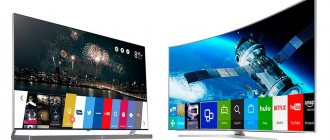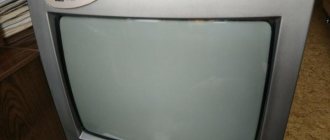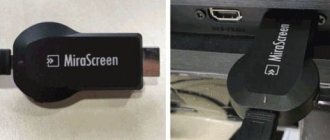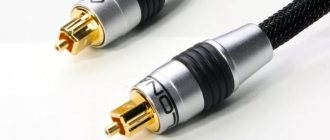Specifications
Reception system:
PAL -B/G/H, -I, -D/K: SECAM -B/G, -D/K, L/L' *
Diagonal:
106 cm (42 inches) *
Screen:
plasma panel, 16:9 ( widescreen) *
Resolution:
Full HD (1920×1080, progressive scan) *
Contrast:
dynamic - over 2,000,000:1, static - 30,000:1 *
Matrix response:
0.001 ms (from signal to bit) *
Viewing angle:
free (180 degrees from any side) *
Speakers:
16x4 cm, left and right, full-range *
Audio output power:
2x 10 W, 10% THD *
Connectors:
1x composite video input (AV3), 2x SCART (AV1, AV2), 1x mini D-sub 15-pin, 1x S-Video, 6x RCA sets, 3x HDMI, 1x headphone jack *
Compatible PC signals:
VGA, WVGA, SVGA, XGA, WXGA, SXGA 60 Hz, 1920x1080 *
Power consumption:
up to 380 W *
Energy saving mode:
yes *
Service life:
100,000 hours *
Dimensions:
103x70x33 cm *
Weight with stand:
27 kg *
Price:
39,000 rub.
Slogan of Panasonic
S-series - “Maximum gaming pleasure” - clearly hints that this is a model for owners of game consoles and media centers. The main question is whether such a TV can handle dynamic scenes and provide decent picture quality?
Screen
The screen is slightly recessed and covered with a durable glass panel (swing guitars and nunchucks to your health!). The matrix is similar to a honeycomb, only rectangular: each cell is surrounded by thin partitions - high, but in moderation - a compromise between the brightness independence of each pixel and the viewing angle. The total number of pixels is 1920x1080, which fully complies with the Full HD standard. To make the broadcast signal look normal on such a screen, proprietary technologies for image enhancement and noise removal are used.
Review of Panasonic TX-PR55VT60. The last plasma in the company's history
Review of Panasonic TX-PR55VT60. The last plasma in the company's historyPanasonic plasma TVs are considered some of the best on the market. At least in terms of indicators. They have the highest screen contrast, perfect color reproduction, and a complete absence of crosstalk (“ghosting”) in 3D. These devices are perfect in everything - except perhaps the appearance, price and marketing system. Samsung devices, aimed at all categories of consumers, are cheaper and easier to sell. Therefore, Panasonic announced that it would cease production of flat-panel plasma TVs.
The VT60 series will be the last in the history of the Japanese company. Its flagship TX-PR55VT60 is equipped with the most advanced technologies developed by the company in recent years. Processor, filter, scanning system, smart capabilities of Smart VIERA, built-in Wi-Fi module, webcam. It even understands you in Russian, supports voice control, and the TV has a special remote control with a touchpad and microphone. Of course, the device is not cheap: you will have to pay about one hundred thousand rubles for it. But for a fan of movies in DVD and Blu-ray quality, such a triumph of technology is almost priceless.
Appearance, design, connectors
The design of the Panasonic TX-PR55VT60 is quite standard. Here you won’t see such shocking antics as stand-up speakers. The screen frame is wide, and the stand is a regular white rectangle. The device doesn't overprice itself like some extravagant TVs from Sony, Philips and Samsung. The plasma panel is covered with thick protective glass, and along its edges there is a thin metal edging, like a smartphone. Sensors are placed on the bottom. Speaker grilles are located on the sides of the case, which allows for increased stereo expressiveness of sound.
They haven't forgotten about high-tech either. It is embodied here by the silver stand. On the one hand, it resembles the letter V (“victory”, victory), and on the other, a stripped-down Honda brand symbol (metal, with a characteristic curve). It looks unreliable, the huge 55-inch screen doesn't look too good on it. The webcam is located in a special slot on top, it can be moved out - small, square, not too pretentious. The color deviations also look rather strange: the screen frame is black, the stand is white, the frame and stand are silver, the back panel is black again. The Japanese have their own aesthetics, nothing can be done about it.
The device is heavy. Even without the stand, it weighs 31.5 kilograms. You can't drag him into the house with just your left hand. But the thickness here is only 5 millimeters. This is almost the only large plasma comparable to ultra-thin LCD TVs. If only there was less gloss... Even from the photo it is noticeable that the screen is prone to glare, and in sunny conditions the situation does not get better.
There have been fewer HDMI ports since last year: now there are only three. Otherwise, the number of connectors is impressive. There are SCART, and RGB, and Ethernet (LAN), and a slot for SD cards, and a digital optical audio output, and a 3.5 mm headphone port, and a Common Interface, and, of course, three USB connectors for mice, flash drives, hard drives and keyboards. In general, everything your heart desires. The ports are hidden in the recess of the case, so the Panasonic TX-PR55VT60 will look very good on the wall. You can make sure that the wires do not stick out, and access to the connectors will always be open.
The tuners installed in the TV support DVB-C, DVB-T2 and DVB-S2 standards. You can connect two satellite dishes to the device at once. The “picture in picture” mode is easily created; the device allows you to view or record two TV channels at once.
Panasonic TVs are among the last to boast assembly in Europe. The panels for them are made in Japan, and the cases are made at a plant in the Czech Republic. Therefore, the Panasonic TX-PR55VT60 is not only weighty, but also strong. The coating does not cause any complaints; the back panel does not crack if you press on it. The device is built tightly, there is no feeling of hollow space. In general, by modern standards the TV can be given a four for its appearance.
Remote control
As befits a top-end device, the Panasonic TX-PR55VT60 arrives with company. In addition to two pairs of shutter 3D glasses, the box with it includes two remote controls. One of them is standard, practical, large and rectangular, with white buttons that can light up in the dark.
The second remote control is compact and more interesting. There are only eleven buttons on it (for switching channels, turning the TV on and off, entering the menu and adjusting the sound level), and a good third of the surface is occupied by the touchpad. With its help, you can quickly navigate the Smart TV interface, browse websites, click on icons, and launch applications. Touch sensitivity can be adjusted in the menu. The new remote control also has a built-in microphone for the TV voice control system. An interesting feature, but of little practical use. Play around for a few minutes and forget about it.
Media player, interface and Smart TV
The media player capabilities of 2013 Panasonic TVs have expanded significantly. Previously, the situation here was not the best: this company competed with another Japanese company, Sony, for the title of the most “greedy” manufacturer. We were not allowed to play unnecessary video formats from flash drives and external hard drives, fearing that it would all be pirated content. But recently, looking at the successes of Samsung, companies realized that in this way they would only lose an even larger market share. And now from their devices you can freely play files not only in MP3, JPEG, WMA and AVI, but also in MKV formats popular on torrents. MTC, M2TC, FLAC, MOV, DivX, H.264 and so on are also available. Additional audio tracks and external subtitles are also perceived by the device. Panasonic TX-PR55VT60 has excellent “omnivorousness”. Problems were found only in compatibility with ISO files (disc images) and playback of DVD and Blu-ray menu covers. However, these problems can hardly be called significant.
The device has a powerful processor; scrolling through high-bitrate movies does not cause any visible difficulties. Also, finally, the device now has the ability to record broadcasts on digital media. It’s a shame that for some reason Panasonic still decides to additionally encrypt this data, so that the flash drive cannot then be inserted into the computer to rewrite it. The recorded information will only be played back on the TX-PR55VT60 and on no other device, but this is significant progress. There is also a built-in Wi-Fi adapter. With its help, data can be received on TV directly via the home network; Plus, it allows you to connect to the Internet wirelessly, which can also be convenient.
The TV menu has hardly changed compared to previous models. Only small parts were modified. The color scheme of all manufacturers has been the same for the last three years: grey, black and blue colors dominate, and all text is always made in eye-catching white. Only LG deviates from this concept. However, the interface looks stylish, it is equipped with clear icons, and at the bottom there are tips to help you quickly get used to the remote control. In addition, even while digging through the settings, most of the screen remains in front of our eyes. We will never miss an important program.
The device includes online help that explains what to do in each menu item. The arsenal of available settings is pleasantly surprising: if you wish, you can “forge” anything from the Panasonic TX-PR55VT60. We are allowed to widely adjust the brightness of the plasma panel, set the white balance and noise level, scale the screen, control color distribution... To access advanced settings, you should go to the “Professional” mode. If you have a calibration device, you are in heaven.
The “smart” capabilities of the latest TVs from the Japanese corporation have also expanded. Of course, they will never reach the level of Samsung, but that was not the goal: if all the basic functions are available, then what else is needed? The local platform is called Smart VIERA (formerly VIERA Connect). There are dozens of applications installed from the factory. There is a timer, a notepad, a service for creating notes, Facebook, YouTube, Twitter, VKontakte, a lot of online TV channels (Russia, STS, RBC), as well as online cinemas like Tvigle and Ivi. On the TV you can freely listen to music or play games (by default they are basic ones like Put Three and Family Reversi).
And if something is missing, please click on the built-in web browser and go to any site you want. Flash is supported, any pictures or video data can be opened. Well, you can always visit Smart VIERA Market to get new applications or games for your TV. And the built-in webcam allows you to communicate with relatives and friends via Skype once or twice, without leaving the couch.
2D picture quality
The device demonstrates an almost ideal color temperature (around 6710 K), as well as an average gamma at the standard level, 2.2. The color gamut fully complies with the RGB standard, making it ideal for watching colorful movies. The picture turns out rich, bright, clear. But the main trump card of Panasonic TVs is still contrast. In this indicator, they are not inferior to the most modern, extremely expensive OLED devices and are many times superior to all other LCD TVs. Devices with a Super AMOLED matrix from Samsung look like babies compared to the Panasonic TX-PR55VT60.
For example: such advanced devices as the Samsung UE-42F5500 (review) had a white to black brightness ratio of 2700:1. And with today's model this value is almost infinite! The black color here is as deep as that of the best TVs from the defunct Pioneer company, its brightness is almost zero. If you want to watch powerful films, if you love thrillers, horror films, noir, the effect will be felt instantly. Finally, black really isn't grey. The picture in the dark merges with the surroundings.
Viewing angles are many times better than any LCD panel. Contrast, color and brightness do not change when watching TV from any point: the cells here are able to distribute light evenly in all directions. The only thing that limits them is the anti-glare filter and the glossy screen finish. The picture in motion turns out to be natural, there are no “steps”. Of course, a device of this class copes remarkably well with sports broadcasts, games and action films: the dynamics here can be seen in all details. In short, Panasonic is the big league. If you want the best picture, if you need a TV for a home theater, this plasma is ideal.
3D picture quality
Panasonic was famous for its 3D mode; it was the best at “active” technology. And yet, the main forces in this regard apparently went to LCD TVs from the VT50 line. The plasma had to cope on its own. As a result, the picture remained the same as that of previous models (Panasonic TX-PR50ST60 review). The stereo depth is good and there is virtually no crosstalk. You can notice ghosting if a white 3D object appears against a black background (there is a slight blur around it). Fortunately, directors and producers are familiar with this effect, so it appears in films extremely rarely.
The set includes two pairs of shutter 3D glasses. They're heavier than polarized ones and don't look as nice, but they can still be worn over prescription glasses, and the brightness remains comfortable for the eye underneath.
Sound
The case has two full-range speakers, and the device has a subwoofer at the rear. The total power is modest, 20 W, but for an ordinary apartment this is quite enough. The sound quality is normal, there is a pronounced stereo effect. The mids are strong, speech is heard crystal clear, but the bass is lacking. When watching TV shows, this is quite enough, but for a home theater it’s worth purchasing a separate audio system.
Results
Millions of people still miss Pioneer TVs, which ceased production in 2010. They are bought from each other on forums, they are repaired, they are proud of them. And Panasonic is even more history and innovation. That's why it's even more difficult to say goodbye to her TVs forever. Maybe we can give the dying king a proper send-off?
If you're looking for a device with top specs, the best possible 2D picture quality, and don't worry about original design, the Panasonic TX-PR55VT60, like any other model in the VT60 series, is a great choice. We can only hope that the good traditions of Panasonic will not be forgotten.
Matrix
The developers guarantee lightning-fast response speed of the matrix and a 180-degree view from any direction - without gradients or dips in brightness. This is especially important for fast-paced games like Wii Sports: thanks to the free viewing angle, you can safely do exercises by jumping around the panel and deviating in different directions without changing the image on the screen.
A contrast of 30,000:1 means that the black tone is not deep purple, but deep and detailed. The dynamic contrast is an incredible 2,000,000:1 thanks to artificially increasing brightness where it is light and thickening blackness where it is dark. Irreversible degradation of the matrix occurs slowly - 100,000 hours of operation are promised, which corresponds to 22.5 years of use, 12 hours a day.
Characteristics
- Type: LED LCD TV;
- Diagonal 40″;
- Screen format 16:9;
- Resolution 1920×1080;
- HD resolution 1080p Full HD;
- Light-emitting diode (LED) backlight;
- Stereo sound;
- Smart TV;
- Year of creation: 2016;
- Refresh rate index: 400 Hz.
That is, the user will be able to be content with a high-quality picture of large expansion on an impressive diagonal plasma.
Moreover, this device has a number of special features. The most interesting development in this development can be called personalized screens.
In addition, the functionality of this TV is average, but it is made with high quality. That is, it is unlikely that you will have to struggle with the settings.
Technologies
The included remote control is extremely versatile: it can be used to control both the TV and other Panasonic equipment: BD players, HD camcorders, receivers, etc. All thanks to VIERA Link technology. The standard settings - Contrast, Brightness, Color, Sharpness - are complemented by three color temperature profiles to choose from, as well as xvColour functions for obtaining the most natural colors and 3D-COMB to eliminate color artifacts with a composite signal.
A surprise for us was the lack of a digital tuner - the European version of the TV has one. You'll have to be content with analog television: channels are searched and sorted both automatically and manually. You can put a password on some - so that children are not tempted to watch their father’s favorite programs, for example.
View photos, videos, 3D
Before we start testing, let's say a few words about the media player built into the Panasonic VIERA TX-PR50VT30. It is quite “omnivorous”: it can play audio files in MP3, WMA and AAC formats, regular photos in JPG and “three-dimensional” ones in MPO. Supported video standards include MPEG4, H.264 BP/MP/HP, DivX, Xvid, VM-1 and WMV version 9. In other words, the built-in media player can easily handle most popular formats and will show videos, photos or play music without any problems.
Now let's start testing to evaluate the Panasonic VIERA TX-PR50VT30 for ourselves. The first test will be “semi-synthetic” - FPD Benchmark for Professional. This benchmark is a selection of test videos and test tables in a resolution of 1920x1080 pixels, recorded on a Blu-Ray disc. The purpose of this test is to understand how smoothly a TV can convey motion and how good its contrast and color reproduction are.
Let’s say right away that the Panasonic VIERA TX-PR50VT30 fully confirms the title of “best European TV of 2011”. You should look for such a depth of black even among plasma flagships. We didn't notice any loss of shadow detail or highlights. This pleasantly surprised us, because when turned off, the glossy screen of the TX-PR50VT30 looks like a giant (50-inch diagonal!) black mirror. However, the glare from external lighting was successfully cut off by the filter.
The color rendition of the TX-PR50VT30 is excellent. The colors are soft, moderately saturated, pleasant. Skin tones are rendered well. If the picture of the Panasonic VIERA TX-PR50VT30 seems too pastel to you, turn on the “Bright colors” item in the menu.
The THX and THX 3D certifications, which we mentioned at the very beginning of the article, guarantee that the TV is capable of showing the very “cinematic” picture that the director intended. When you turn on THX mode, colors on the screen become softer, color reproduction becomes even more pleasing, and shadow details continue to remain as visible as in normal mode.
The Panasonic VIERA TX-PR50VT30 TV also demonstrated excellent clarity in dynamic scenes - we did not notice any blurring of the image, nor, in fact, any artifacts in extrapolated frames created by the TV processor.
The hero of our review passed the “semi-synthetic” tests brilliantly, and it’s time to try it out in action.
We launch the How to Train Your Dragon Blu-ray disc and immediately see the same thing that we saw in the test videos from the FPD benchmark: good color rendition, clear rendering of details in the shadows and excellent, smooth dynamic scenes. In 3D mode we were unable to notice any artifacts. The stereoscopic image was clear, with no blur or ghosting. There was also no noticeable “tail effect”, which is only observed with some plasma TVs.
The sound of the built-in 2.1 speaker Panasonic VIERA TX-PR50VT30, of course, cannot be compared with the sound of a multi-channel 7.1 system, but it still turned out to be quite decent and pleasantly surprised us.
And finally, let’s say a few words about the shortcomings that, due to the nature of the technology, are inherent to one degree or another in all plasma TVs.
The first is called the “war of germs.” Because of it, up close it seems that there is something between the picture and the glass of the screen, and this “something” moves and flickers. However, with increasing distance on good TVs, this effect disappears, the image again becomes clear and unclouded. So, from a meter on the Panasonic VIERA TX-PR50VT30, the “germ war” can no longer be seen. Let us remind you that the diagonal of the TV is 50 inches, which means it is comfortable to watch from a distance of one and a half meters or more.
The second known flaw occurs due to pixel burn-in in places where static elements such as a channel logo or menu items are reflected on the screen, and is called memory effect. However, there are effective means to combat it. If you turn on the “Pixel Protection” option in the TV menu, then in static images (and these are the ones that harm the plasma), the pixels will begin to tremble for a few seconds every few minutes, then the picture will be restored. This preventive measure will protect the screen from damage. Well, if you didn’t know about this option, the memory effect has already begun to appear and the residual image is noticeable to the naked eye, activate the “White stripe” item in the menu - a white vertical stripe about 10 cm wide will appear on the screen, which will shift left and right, gradually erasing annoying elements and restoring the original condition.
SMART TV
SmartTV Panasonic Viera TX 40DSR410
Many manufacturers are adding SMART TV technology to their lineups. The Panasonic Viera TX 40DSR410 was no exception in this regard.
In general, this development is quite user-friendly. Suitable for both work and other entertainment purposes.
The main task of manufacturers in this regard is to provide customers with a simple and convenient device for working with network resources. This is usually done using remote controls.
They are developed using special technologies so that with one such remote control you can use all the functions.
That is, one device will consist of a joystick, a mouse and a regular control panel.
An important factor is working with content.
The problem is that smart devices create some competition with the main TV channels.
The latter, in turn, can even limit the display of multimedia materials on your TV.
Also, TVs with Smart TV function in most cases support external Wi-Fi adapters that provide wireless access to the Internet.
Sound
Dolby Digital
The Panasonic Viera TX 40DSR410 operates on the basis of a stereo audio system - “Dolby Digital”.
Sound power - 20 W. Each audio output is rated at 10 watts. These are quite good indicators of sound volume.
For everyday use you don't need more.
If you are still not satisfied with this indicator, you can buy an amplifier.
You can listen to music in the following formats: AAC, FLAC, MP3, WAV, WMA.
Thus, you can safely buy licensed tracks and not be afraid that they will be read by the system in an inappropriate way.
TV also doesn’t particularly avoid pirates.
Dolby Digital
“Dolby Digital” is a fairly well-known multichannel sound system, founded back in 1992.
Thus, it can be called a proven development. “Dolby Digital” was also used in cinemas.
This audio system contains six independent channels.
They are the ones who are directly involved in the process of creating a three-dimensional sound image.
That is, this happens through the optical output.
Audio Modes
This model also supports the following modes:
- “Standard” - everything corresponds to the original settings.
- “Music” - focused on improving the sound of tracks
- “Speech” is relevant for watching news, talk shows and similar television programs.
- “Custom” - allows you to change the indicators depending on your needs.
Developed by Panasonic
Viera on Panasonic
The brainchild of this company is the Smart VIERA concept. She is responsible for the non-standard capabilities of televisions.
For example, this means:
- VIERA Connect - receiving multimedia files and working with installed programs;
- VIERA Image Viewer is a video player where you can view photos from SD memory cards;
- DLNA - a function for connecting various devices via a wireless network;
- Wi-Fi Direct;
- VIERA Link - control devices connected to the TV using the TV remote control;
- USB connection - the ability to connect the devices you need to the TV via a USB port, including a keyboard for additional comfort when working with the Panasonic Viera TX 40DSR410.
- Support for flash media and external HDDs. This way you can play media content of the most popular formats, for example, in MKV (Matroska).
Thus, new technology and its trends are slowly moving towards the concept of a “smart/digital home”.
This indicates powerful synchronization of all devices using the Internet network.
For example, watching a recently recorded video from your phone will be as common as making tea.
You no longer need a lot of special cables; the Internet network will handle everything itself.
Design
Dimensions Panasonic Viera TX 40DSR410
The manufacturer emphasizes that the Panasonic Viera TX 40DSR410 has a classic design. And we can completely agree with this.
This black TV looks neat and minimalistic.
In addition, the display itself is quite large.
It is perfect for family viewing - the screen will be visible to everyone.
This size is also convenient for surfing the Internet and broadcasting various types of multimedia.
In addition, the main concept of the model is ease of use. This is clearly visible in the menu interface: everything is clear, you can figure it out intuitively.
Additional connectors
Panasonic Viera TX 40DSR410
Users often complain that they lack a headphone jack.
However, in this model you will not have to face this problem - there is a 3.5 mm port.
In general, you can connect quite a lot of things to the Panasonic Viera TX 40DSR410:
- 2 HDMI ports;
- LAN port;
- 1 output for USB 2.0;
- TOS Link audio input;
- 1 CI interface (version 1.3);
- 1 SCART;
- 1 RCA;
- 1 digital audio output (optical).
Therefore, connecting something to this device will not be difficult.
Playing video
Panasonic Viera TX 40DSR410
Panasonic Viera TX40DSR410 has an LED screen. Accordingly, this affects the price, but provides good image quality.
The main advantages of such displays over LCDs are:
- they are thinner and lighter than other types of LCD screens. You can easily hang such a TV and not worry about its safety;
- they have a more realistic image with optimized contrast and clarity settings than LCD matrices;
- Although the cost of such a TV itself is considerable, you can save money by using LED backlighting. It allows you to reduce consumption by up to 40% compared to LCD;
- LED backlight does not contain mercury, so even if the screen breaks due to careless handling, you do not have to worry about the health of yourself and your loved ones;
- wide range of functionality: the latest devices have a large number of connectors and interfaces for your digital equipment. In addition, they are “omnivorous” - they support various audio, photo and video formats and even provide the ability to access the Internet.
Smart screen dimming also has a positive effect - it improves image contrast, first of all. Accordingly, you get a juicy and realistic picture.
Video playback modes
Most modern TVs have several modes to improve the picture. Model from Panasonic as well. She has:
- “Dynamic” - enhances the parameters of sharpness, contrast and brightness.
- “Standard”—default settings.
- “Cinema” - the device adapts to the film and optimizes the image for these purposes.
- Immersive Cinema is a more advanced mode than the previous one. Thanks to this, not only the picture improves, but also the sound itself.
- “Custom” is an individual mode where you can configure everything as you wish.







